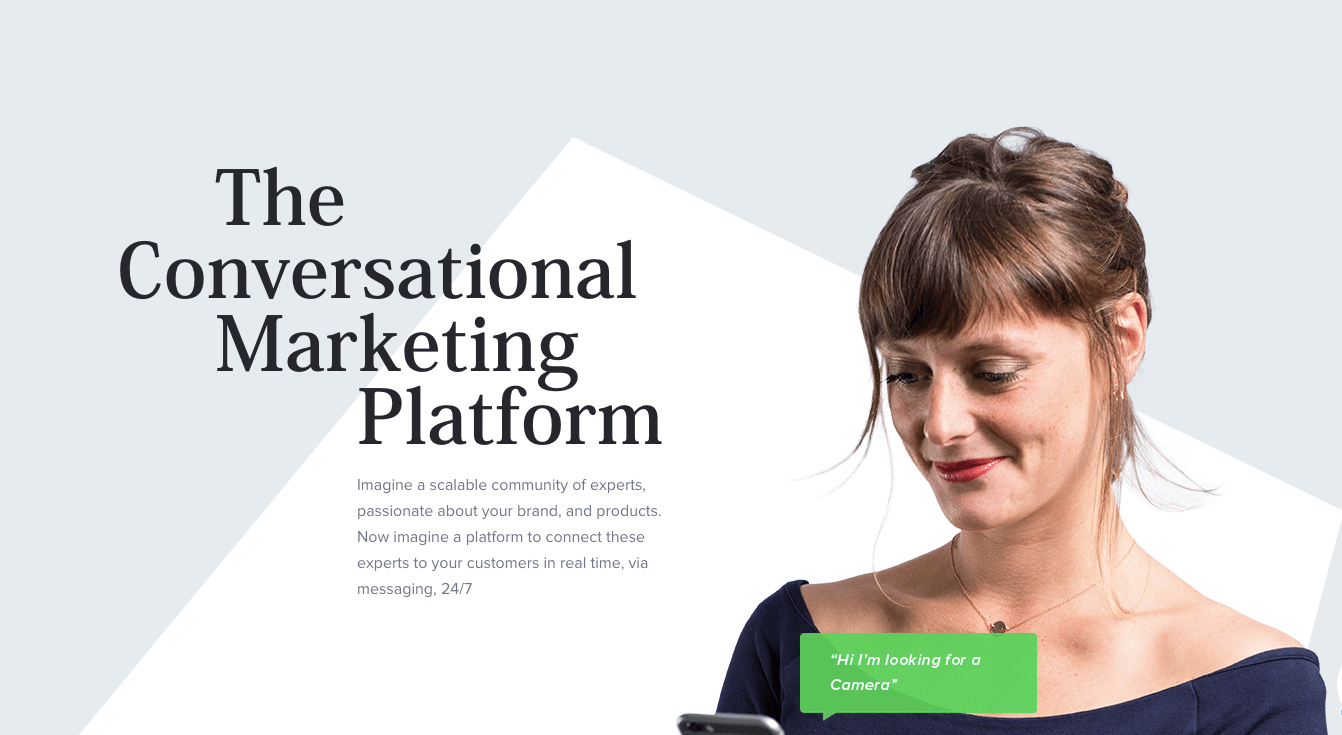
How Personalisation Helped To Build A Loyal Customer Base
We sat down and popped open a bottle of Prosecco with Fran Langham, Head of Marketing at iAdvize, to hear everything she had to say about personalised prospecting. iAdvize is a conversational marketing platform for businesses who, like us, really want to build relationships with their customers.
Most good brands realise that their effort needs to go into focusing on creating real customer relationships to have a business that has genuine fans who love to talk about them.
Q: Can you give us a brief overview of iAdvize?
A: iAdvize is a full stack conversational marketing platform. Our mission is to make the online customer experience authentic. We do that by connecting online visitors with passionate experts. We have independent experts logging into our app which then feeds into our platform and who are having real-time conversations and advising visitors online.

Q: So, are your independent experts on standby all the time, waiting for people to ask them questions?
A: Yes. The full story is that we started seven years ago as a ‘live chat solution’; the idea was to allow customer service agents to answer online visitors in real time. The first problem we were trying to solve was to reduce the volume of emails and make interactions more human, rather than sending an email and waiting two weeks and not getting a reply.
Then, we moved into proactively targeting people in the right way and only focusing on the people who need that assistance. So rather than a static popup, we’d only trigger a message if it looks like they are going to abandon the site or have spent five minutes hovering over a certain product.
We realised that there’s a gap of missed opportunities during the hours that a business isn’t open (typically evenings and weekends). We thought about ‘what if we could find knowledgeable people that could make up the missed opportunity and respond in their free time.’ So we tried it and when we started comparing the stats, we noticed that the independent experts were getting a higher satisfaction rate than the agents. This ‘peer-to-peer advice’ was making customers feel something because it was authentic.
Now we have around 15,000 experts!
Q: What does ‘conversational marketing’ mean to you at iAdvize?
A: Conversational marketing means many different things to different people. Lots of companies use the term in relation to chatbots, voice, audio and AR. To us, it’s a personal touch, “human-to-human".
Q: Take us to the top of your funnel. Where do you start when it comes to lead generation?
Predominately, the most significant part of our strategy is events. It serves a duel-purpose regarding lead generation and brand awareness. We talk a lot about being more human and face-to-face interactions, and the only way you can do that is by meeting someone at an event and then nurturing them afterward.
It’s important to ask yourself what works for you. At the start, we were going to expos and every big retail event in town and getting a few hundred leads that weren’t viable or interested in our business. However, we’ve found that we get a stronger impact when we do things differently. We ask ourselves which niche events will lead to the most qualified leads, or help us showcase who we are. We were reluctant to try this at first because we were worried that there would only be 10-20 retailers in the room, but we couldn’t imagine the difference it has made. Having engaged conversations with two out of ten targeted retailers has worked out a dream for us.
We also do a lot of networking. I go to a lot of marketing and retail meetups, and there are loads of companies and like-minded people who have the same mission as us. I’ve found that it’s more impactful to meet companies that have the same humanised, personalised vision, then we can partner up to find people that have a need for both of our services and discuss hosting events for them together. It means we can then team up and invite customers and people in our pipeline that would have an interest in both companies. Then you can all share ideas of where else to go and what to do. That itself has been a massive learning curve for us! It’s all about quality over quantity.
Q: If people still go down the road of ‘business briefings with an agenda’ complete with full-blown pitches and presentations, it leaves no space to learn anything from the people you invite. However, your invitation states that your events are different and that they include "no presentations, speeches and zero sales - just great people and excellent food". Where do we sign up?
A: We held an event called ‘A Conversational Breakfast’, and we invited Facebook and WeChat to speak. We didn’t have many customers in the UK at the time, so we invited prospects to come and talk about what their missions were, it doesn’t have to be ‘pro-iAdvize’ it can be about chatbots or AI, to get the conversation rolling. We also invited our independent experts too and shared their authentic stories about why they chat on behalf of brands.

Q: Lead generation is such an essential part of your marketing role. Can you tell us about the relationship between marketing and your business development managers?
A: We have an account-based marketing strategy, and it means we have a target list that’s segmented by industry and each member of the sales team work on their particular remit. The key is to work closely with sales. We check-in every day, speak all of the time and run campaigns together. One of the reasons that the marketing campaigns are so successful is that the sales team are contributing to them. When we did a sports retail campaign, we asked the sales team to collaborate on a white paper we were creating, because the sales team know the essential details surrounding their clients’ business and who their competitors are, so it makes total sense that they contribute their vision. We then do a fully integrated campaign and blend in some traditional marketing in with our ABM (account-based marketing). We’ll send emails, but we’re not just going to send them for the sake of it, it’ll be personalised, then the BDRs and BDMs (business development reps and managers) will follow up and ask “Did you receive it? Was it of interest? What did you learn from it?” We usually then follow up with video content, something short and useful.
We’ll only take actions that we feel are human and make sense. As part of the sports retail campaign we used Inkpact for, we thought ‘Let’s send them a handwritten note and a handwritten follow-up’. Its things like that that are out of the box, teamed with traditional marketing tactics that we hope creates the perfect recipe. We are always testing and tracking!
Q: Do you send anything more specific to certain people within sectors? Would you deliver a handwritten note to people who are at a particular place in the sales cycle, or do they all get treated the same way?
A: It varies. It depends on where the client is in our pipeline. We can sit with sales and create something super personalised for one or two people. As long as we think it’s going to have an impact, we’re not restrictive. In previous roles, even I have said: “If it’s only going to 5 people, it’s not worth it, let’s use the resource wisely.” However, it’s about understanding the businesses that you’re prospecting and building that lovely relationship with the contacts inside that business. Know them so that you can say ‘I know that this person will appreciate this because’ or ‘that person doesn’t like receiving emails because they get 200 a day’ it’s about asking the right questions when you meet the prospects so the follow-up can be as close to what they want as possible.
By having a small target list and knowing those businesses, it’s made it a lot easier for us to say 'I met this person at the event and they specifically mentioned this’; it’s about that ‘wow’ factor.
Q: Have you learned any lessons from prospecting campaigns that didn’t work?
We used to call our marketing ‘ABM’, but we were just emailing everyone, which means you’re hoping that you’ll get some response and checking your open rates all the time, but we were wasting our time as we weren’t doing it for a specific reason. We’ve learned you should never do something for the sake of doing it. We ask ‘why’ all the time, ‘why am I sending it to this person’? ‘why will they want it’? If you send out a white paper for no reason, you won’t get a good response. However, if you send out a customer experience white paper because you’re actually doing an event on customer experience and you want to educate people ahead of the event, and then they attend, you can then send a follow up with more content it makes more sense.
You’re never going to find one channel that gets the full return. Sales teams sometimes say “calling doesn’t work”. It’s true, and it’s the same with emails if you’re just doing that. But a little bit of calling, a few emails, or a personalised handwritten note at the right time to the right people, with the right intent...that’s what helps you connect.
It all comes back to treating others as you’d like to be treated yourself. It’s all about how it makes you feel.
Q: When it comes to delivering things to clients, how do you find the right balance between sending something that doesn't feel like a bribe and something that’s relevant to both the company and customer?
A: It's more of a question about ‘who’. If you send something to ten people and it goes well, everyone is always inclined to say ‘scale it!’, but the point with ABM is that you can’t scale it. That means when you keep your efforts focused to people with whom you've met already or had conversations with, it feels real and genuine because it is.
We won’t send chocolate out to strangers that we’ve had no touchpoints with anymore, but we are testing sending handwritten notes to people we don’t know. However, in that case, the context is everything. We have made sure that the message is honest by introducing ourselves and explaining why we’d like to meet them, complete with cute quips about ‘the old art of letter writing’.
Q: A lot of what we do is because it’s the right thing to do, yes, you’ll get ROI on it further down the line, but it won’t be immediate if it’s a loyalty campaign. How do you pitch that internally when it’s the type of marketing that 'feels right' to do?
A: It’s important to be clear on why you’re doing something and manage expectations. It goes back to knowing ‘why’ you’re doing it. We always need a certain amount of ROI as sales want leads and conversations, but we don’t measure it regarding “we went to this event and got X amount of deals”. Often, we measure the ROI on conversations we’ve had, we give our prospects an engagement score, and automation is built in to monitor actions they make. ‘Has attended an event’, ‘has opened an email’, ‘has visited the blog’ etc. We use that as a guide to judge. As long as we’re continuously increasing that engagement score and we’re not getting an unsubscribe or going into the minus, then we believe that it’s positively impacting and that is our ROI scale.
Yes, also if a business goes through a change, re-brand, or does something new, you need the customers or audience to be invested so that they’ll find the patience and want to move with you. We were talking about Typeform earlier, they’ve recently had a total rebrand. Their platform had changed, they’d redesigned the user journey and features, but because I loved their brand and used their product so much, I just took the time to get to know it. They’ve never harped on about me needing to use Typeform; they’re very conversational and great at showing you the value they provide and therefore, I’ve stayed with them since I joined three years ago.
Yes, if they’re conversational and teaching you something, then you don’t mind so much. We had repositioning in October. We went from being ‘all about the technology’ to ‘all about the human touch’ and putting the independent experts at the forefront of our strategy. You have to get people to champion that then, and it can take a long time. You have to redo your content and approach. You have to take things one step at a time. First, we're getting the messaging straight and meeting the right people, and then next year we might start asking a little bit more.
Thanks so much for taking the time to share all of your insight. We found that very insightful and we know our readers will too.
To summarise, if you’re getting stuck with your prospecting:
- Know your audience.
- Go with what feels right, ask yourself, “Would I like to receive this?”
- Scrap email templates. Just send notes and messages from your email account.
- Be brave, go against the grain, even if the company has been doing something for years.

